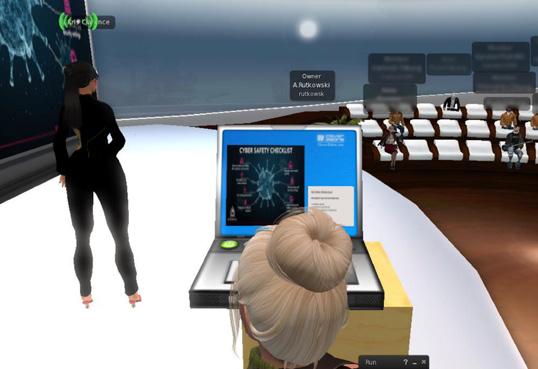
4 minute read
Second life for Second Life
Virtual education: a specialty in its own right
Going to your study group on a horse and attending lectures in an amphitheater on an island: for Anne Rutkowski’s students this is the most normal thing in the world. Rutkowski teaches in the virtual world Second Life.
Text: Irene Faas
Each with their own avatar, the students walk into the amphitheater. Some look like themselves, others have dressed up as an angel or a zombie. The avatars sit down, while the avatar of Professor of Information Management Anne Rutkowski stands in front of the group to start her lecture. This virtual environment is part of the program Second Life, designed to simulate a social, virtual world.
“It’s really an environment and not a game,” stresses Rutkowski. “In a game, you have a goal to work towards. By completing tasks, you can achieve that goal. Second Life doesn’t have that: its only purpose is social contact.”
Natural contact
Rutkowski first used the program in 2008, when she led a project with students from, among others, Hong Kong and the United States. In 2010, the project ended and with it her use of Second Life. When the country was shut down by the corona crisis and scientific education went digital, Rutkow
Anne-Françoise Rutkowski
Anne-Françoise Rutkowski is Professor of Information Management. With her background in psychology, she bridges information systems and social sciences with topics such as decision-making, emotions, and socially responsible use of IT. Applications of her research can be found in organizations with a great deal of responsibility, such as hospitals or banks, with a focus on decision-making or cyber security.
ski breathed new life into the program. “I knew right away I wanted to use Second Life again,” says Rutkowski. “I teach a course on innovation, so I thought it would be a good opportunity to introduce students to a new technology.” The classes look just like on a real campus: Rutkowski gives lectures and groups of students can work in their own workspaces. Outside is a square where students can relax and catch up. If they have any questions, the students can come by Rutkowski’s office.
“Second Life is a much richer environment to teach in than, for example, Zoom,” says Rutkowski. “Zoom works just as well for a lecture, but for discussions and interaction Second Life offers many more options.” For example, she can drop in on the groups of students to see how things are going. Conversely, students can wait for her when she’s talking to someone else. “You see the same natural dynamics that you see on campus.”
It is also easy to have discussions or share ideas via Second Life. “We can hang posters on the wall to pitch ideas,” says Rutkowski. “Then you can walk over to them together and look at them. The interaction begins spontaneously: you really have the feeling that you are together.”
Research tool
Rutkowski knows her way around Second Life. She uses it not only in education, but also for her research. “In psychology, we
make a distinction between space and place,” explains Rutkowski. “When you enter a new office, it’s a space. If you then display your own photos and decorate it to your liking, it becomes a place: it’s your office now.” The feeling of “place” only ari- ses when you are familiar with the space and experience a feeling of familiarity.
Together with a colleague, Rutkowski researched how the movement of objects affects the sense of place. When designing our virtual world in Second Life, we paid extra attention to objects and how the avatars can move them,” says Rutkowski. “The more directions in which the students could move or rotate the objects, the more they got that feeling of place and familiari- ty.” Second Life serves as a tool for research in virtual environments.
Virtual Venice
Even after the corona crisis, Rutkowski sees plenty of applications for Second Life. “It’s certainly a sustainable option for educati- on,” she says. “Students don’t have to travel anymore. We can use Second Life for a number of educational activities, but I wouldn’t use it for full courses. It is perfect for use with international students.”
Apart from scientific education, Second Life can also be useful for other meetings. Rutkowski cites policy development as an example. Project groups of the European Union already use it. The program can also be a good addition for language courses: it allows participants to learn Italian in a vir- tual Venice. “In the United States, they even use Second Life to organize prom now that the students have to stay at home because of Covid-19,” says Rutkowski.
Second Life offers many possibilities. The program creates a feeling of together- ness when real togetherness is not possi- ble. “You really feel like you’re somewhere else,” Rutkowski agrees. “As soon as I log in, I’m in Second Life. I’m not home anymore. It’s a complete psychological immersion.”
The Innovator Corridor is the place to brainstorm with your team.
Knowledge Management lecture from a student’s perspective.
Cybersecurity guest lecture in the amphitheater.














